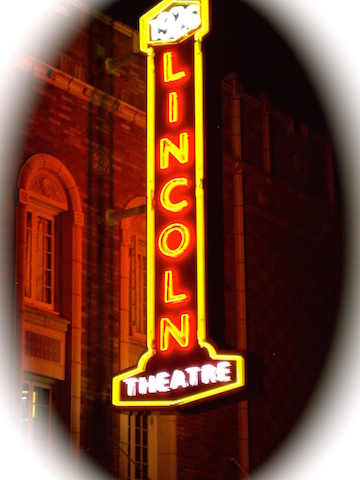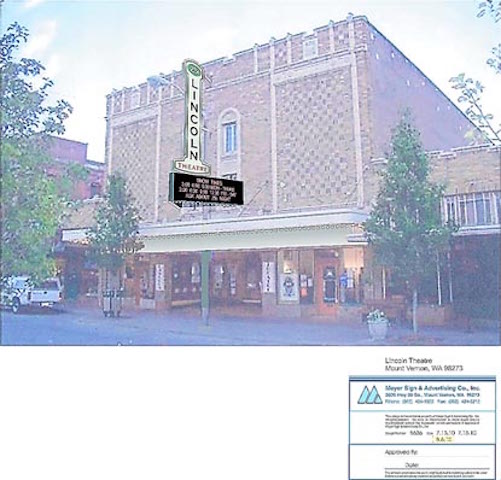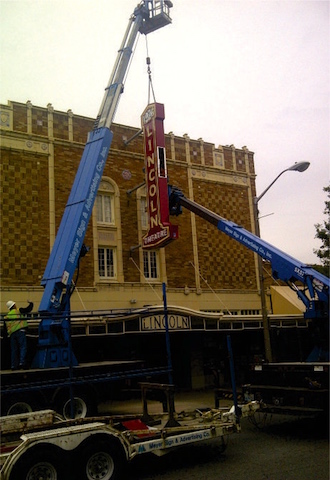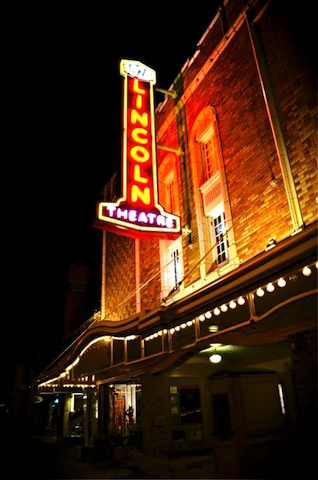
Quick…name that building!
Ask anyone even vaguely familiar with Mount Vernon to name its most iconic places, and you can be pretty sure that the
Lincoln Theatre will be prominently mentioned. There was a time not so very long ago, however, when passersby might have driven through downtown Mount Vernon and given no more thought to the building’s significance beyond the attractiveness of its facade.
Oh, what a difference a sign makes!
The theater’s executive director, Roger Gietzen, recalls having entertained this very thought when he first arrived in Mount Vernon in the early ‘90s.
“There was a lettered marquee that told you what was playing if you knew to look for it,” Gietzen recalls, “but there wasn’t a big lighted sign similar to those you saw at other historical theaters in the area.”
As Gietzen became more involved with the Lincoln (he was named interim director in September 2013, and executive director last May), the Lincoln Theater Center Foundation (founded in 1987 to manage the theater on behalf of its owner, which was to eventually become the City of Mount Vernon) was taking major steps to return the building to its former glory. These steps included the restoration of its classic brick facade and the addition of an awning and a foyer box office.
While these latter additions brought the building’s appearance closer to its 1926 origins, one element that was conspicuously absent was the large neon sign that had identified it for decades — a sign that had existed until its removal in the ‘80s due to safety concerns.
Ironically, it was concerns over historical authenticity that made the Lincoln Theatre’s sign replacement a source of debate among some Foundation members. The crux of the issue was that there was no evidence of the sign in the original architectural drawings — a fact that Gietzen viewed more as a matter of omission than historic veracity.
“While we don’t have photographs that show what the building looked like on the day it opened, we do have photos going back to 1926 (the year it was built) that clearly show that the sign was there,” Gietzen explains.

Buddy, can you spare a quarter?
Besides Gietzen and others in the Foundation, a major proponent of restoring the theater’s sign was the Mount Vernon Arts Commission, which favored a traditional neon design over a more contemporary LED version. After nearly 20 years without its neon symbol, the theater’s Foundation gave the go ahead to began work on a replacement and engaged David Hall of
HKP Architects to take a first pass at a design, which became the basis for what Meyer Sign & Advertising ultimately created.

A working design of the new Lincoln Theatre sign includes a hint as to a potential Phase 2 of the project. We could tell you more, but then we’d have to kill you.

Work in progress. Fabricating the Lincoln Theatre sign in our shop.
In May 2011, following months of fund raising, the Lincoln had its sign back. Among those instrumental in its installation was Mark Vorobik of
EDCO, Inc. Mark was a board member, and his influence was instrumental in guiding and assuring that this sign project, despite a number of challenges, was completed on time and on budget. His company also fabricated and donated the mounting structure for the sign, which further ensured the project’s completion within budget. We’re proud to say that Meyer Sign & Advertising also made a donation toward that end as well — proving that success does, in fact, have many fathers.

The big day comes at last.

Meyer Sign & Advertising’s Brett Milton helps install the new Lincoln Theatre sign in May 2011
Comparing the original sign with its successor, one notices a couple of things right off the bat. One is that the new sign is shorter. The other is that the original had the seemingly random addition of ladders on either side. Both these differences tell us a little something about changing times. Today’s regulatory environment prohibits the Lincoln’s sign to extend above the top of the building. And the ladders? Back in the ‘20s, film technology used silver nitrate, a highly volatile chemical — a fact that not only explains the need for a quick escape, but also why the theater’s projection room had fire proofing.

Although increasing the “visibility” of the Lincoln while honoring its history — and by extension, that of Mount Vernon — were the primary drivers of the Foundation’s efforts to bring back what had been missing for over two decades, the theater’s sign restoration has additional meaning for Gietzen. For one thing, it creates yet another powerful visual experience of the Lincoln’s brand. Sitting with him in the middle of the theater as a set is under construction for an upcoming community theater production, he looks around at its restored interior.
“When people think of the Lincoln, they think of this,” he says, “the inside of the theater. But since the sign has gone up, they think of its exterior as well.”

Questioning Gietzen about the brand that the Lincoln’s new sign is meant to project, he speaks of its history and that of other iconic theaters in nearby counties as islands of culture and entertainment in what was still thought of as the American Frontier at the beginning of the 20th Century. From its origins as a vaudeville and silent film venue (Wurlitzer performances before a movie are still one of the unique parts of the Lincoln experience) the theater has expanded its cultural offering to include a
year-round schedule of concerts, current and classic films, community events, and live broadcasts of the National Theatre in London and New York’s Metropolitan Opera.

At the core of the Lincoln Theatre brand, however, is community. As a registered non-profit organization supported by hundreds of members from the Skagit County and beyond, the Lincoln’s community outreach is best summarized on its website: The theatre works with local school districts, hosting school performances and workshops by performing artists on tour, as well as annual concerts by secondary school bands. The theatre hosts concerts by the local youth symphony, presents community-sponsored children’s theatre productions, as well as serving as a venue for fund-raising events by local service organizations.
If that isn’t a brand worthy of a sign of iconic proportion, we don’t know what is.

Is it hyperbole to refer to the Lincoln Theatre as the jewel in the crown of downtown Mount Vernon? We think not.
By the way, if you’ve yet to experience the Lincoln, Roger Gietzen highly recommends getting tickets for Irving Berlin’s holiday musical, “White Christmas,” which opens on November 26 and runs through December 13. It’s a great way to celebrate the season and experience both a piece of Mount Vernon’s history and our vibrant community theater scene.










